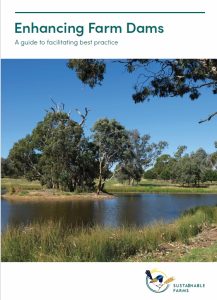 Farmers and government staff have a new resource to help them change a common feature of the rural landscape – the farm dam – into a major centre on a farm for conserving native plants and animals of their local region.
Farmers and government staff have a new resource to help them change a common feature of the rural landscape – the farm dam – into a major centre on a farm for conserving native plants and animals of their local region.
Nearly 60 percent of Australia’s landmass is owned or managed privately. For the long-term survival of the nation’s biodiversity, private landholders must be included in expanding protected areas for conserving Australian landscapes and heritage. [See research on this topic here.]
For nearly 30 years, ecologists and farmers in the Australian National University’s Sustainable Farms project have investigated the impact of enhancing or extending existing on-farm natural assets to better conserve biodiversity on private lands in Southeast Australia. These assets include farm dams, creek lines, remnant woodlands and rocky outcrops.
While they found that farm dams provide important conservation areas for native animals, enhanced dams can also improve livestock health and production; improve ecosystem services for surrounding crops and pastures; improve water quality; reduce water evaporation and increase storage; and reduce on-farm greenhouse gas emissions.
Drawing on research and past farmer experiences across Australia and overseas, the project has developed training materials and resources to help Landcare and other community groups that include farmers to establish and enhance these natural farm assets.
With assistance from The Comms Doctor, Enhancing Farm Dams: A guide to facilitating best practice, was developed for farmer group leaders and Landcare coordinators to provide information and training to private landholders across Southeast Australia on how to enhance their dams for local biodiversity.
Project Director Michelle Young said guides were being produced “as a supporting resource for ‘train the trainer’ workshops in best practice natural asset management, offered by Sustainable Farms.
“[The Guide] provides NRM facilitators and other farm advisors with a framework based on adult education theory, to teach landholders the guiding principles and best practices for managing natural assets.” Enhancing Farm Dams: A guide to facilitating best practice is provided to course participants in the project’s ‘train-the-trainer’ workshops.
As well as information in the guide, participants can access additional materials produced by the project and made available on the project website, including videos, podcasts, farmer case studies, and technical guides. These can provide meaningful learning experiences for farmers and community members who seek to turn farm dams into ‘oases’ for local biodiversity while improving the value and production of their properties.
Contact the Sustainable Farms project team if you are interested in a ‘train-the-trainers’ workshop – send an email to sustainablefarms@anu.edu.au.
Need advice on communicating about your project that encourages natural resource management on private lands? Contact The Comms Doctor for an initial half-hour consultation to discuss your communication needs.

